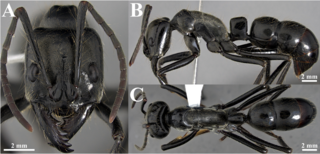
Ponerinae, the ponerine ants, is a subfamily of ants in the Poneromorph subfamilies group, with about 1,600 species in 47 extant genera, including Dinoponera gigantea - one of the world's largest species of ant. Mated workers have replaced the queen as the functional egg-layers in several species of ponerine ants. In such queenless species, the reproductive status of workers can only be determined through ovarian dissections.

Paratrechina is one of seven ant genera in the Prenolepis genus-group from the subfamily Formicinae. Six species are included in Paratrechina; one of which, the longhorn crazy ant, is a widespread, pantropical pest.

Dinoponera gigantea is a species of ant belonging to the family Formicidae.

Aenictus is a large army ant genus distributed in the Old World tropics and subtropics. It contains about 181 species, making it one of the larger ant genera of the world.

Dinoponera is a strictly South American genus of ant in the subfamily Ponerinae, commonly called tocandiras or giant Amazonian ants. These ants are generally less well known than Paraponera clavata, the bullet ant, yet Dinoponera females may surpass 3–4 cm (1.2–1.6 in) in total body length, making them among the largest ants in the world.

Cerapachys is a genus of ants in the subfamily Dorylinae. Species are mainly myrmecophagous ants which raid the nests of other ants for prey. The genus is distributed widely throughout the Indomalayan region. The genus was revised by BoroWiec (2016) who split a number of previously synonymized genera out of Cerapachys, leaving only 5 species in the genus.

Dinoponera mutica is a queenless species of ants in the subfamily Ponerinae.

Dinoponera quadriceps is a queenless species of ants in the subfamily Ponerinae. The species, known from Brazil, is similar to Dinoponera mutica and uses venom for subduing large live prey and defense. Its venom could be of use to the pharmaceutical industry.
Dinoponera snellingi is a queenless species of ants in the subfamily Ponerinae. The species is known only from type locality in Campo Grande, Brazil.

Dinoponera longipes is a queenless species of ants in the subfamily Ponerinae.

Dinoponera hispida is a queenless species of ants in the subfamily Ponerinae. The species is known only from the type locality in Tucuruí, Pará, Brazil.

Dinoponera lucida is a large queenless species of ant in the subfamily Ponerinae. The species, endemic to Brazil, is threatened by habitat destruction. Workers range from 27 to 30 mm in body length, which is slightly larger than the related species Dinoponera australis, but smaller than other large ants. Males are unknown.

Archiponera is an extinct genus of ant in the formicid subfamily Ponerinae. The genus contains a single described species, Archiponera wheeleri known from several Late Eocene fossils which were found in North America.

Myrmelachistini is a tribe of ants in the family Formicidae. There are at least 2 genera and 50 described species in Myrmelachistini.

Formica ravida is a species of ant in the family Formicidae.

Camponotus chromaiodes, known generally as, the ferruginous carpenter ant or red carpenter ant, is a species of ant in the family Formicidae. Acetobacteraceae are found in the guts of workers in this species.

Formica obscuriventris is a species of ant in the family Formicidae.

Formica moki is a species of ant in the family Formicidae.

Formica neogagates is a species of ant in the family Formicidae. Found throughout North America and Canada, introduced in Europe, France.
Camponotus vittatus is a species of carpenter ant and one of the most common ants found around households in South America, particularly Brazil. It was originally described by Auguste Forel in 1904. The species is relatively large, caramel-coloured, omnivorous, and fast-moving. The species presents four larval stages which will spin a cocoon to pupate. The hairs of Camponotus larvae are quite abundant, and may present taxonomic importance. The larvae of both sexes are similar, with few diagnostic traits, such as the acquired shape towards pupation inside their cocoons.



















